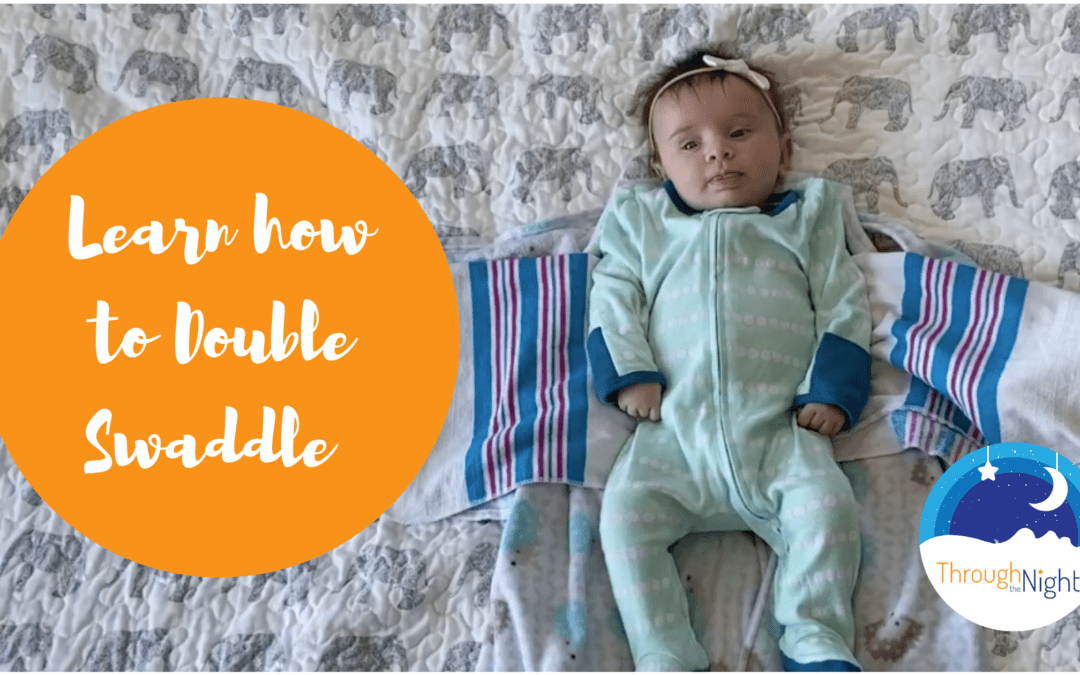Today, I’d like to show you how you can double swaddle a baby. When would you use a double swaddle (or “super swaddle”) – – when your newborn or infant is breaking through a standard single swaddle or when your baby’s arms are coming up and out of their sleep sacks AND when they are still safe to swaddle.
Recently, my friend Reba reached out to tell me about her newborn girl who seemed to have pretty great sleep habits, except for one big problem – – she could NOT keep her swaddled. This baby was born with superhero strength and Houdini-like swaddle escape skills. If you met her mom, you’d have no shock about how that happened. The unfortunate side-effect of a baby that can get their arms free and for whom a “miracle blanket” does not work…is 20-40 minute limits on sleep. This mom (and baby) was exhausted.
She decided to get on my schedule for a full consultation and we went over the 5 Steps to Predictable Sleep. During our Private Coaching, it was confirmed that Reba was guiding her little one to great safe sleep habits and at this point needed help with figuring out how to keep her babe swaddled.
What are the benefits of swaddling?
Dr. Harvey Karp, creator of “The 5 S’s for Soothing Babies” describes the benefits of swaddling in his videos, books and blog. According to his blog: “Swaddling recreates the snug packaging inside the womb and is the cornerstone of calming. It decreases startling and increases sleep. And, wrapped babies respond faster to the other 4 S’s and stay soothed longer because their arms can’t wriggle around. To swaddle correctly, wrap arms snug—straight at the side—but let the hips be loose and flexed. Use a large square blanket, but don’t overheat, cover your baby’s head or allow unraveling. Note: Babies shouldn’t be swaddled all day, just during fussing and sleep.”
How do we swaddle safely and is double swaddling safe?
The “American Academy of Pediatrics, (AAP) says that when done correctly, swaddling can be an effective technique to help calm infants and promote sleep.” More details about safe sleep recommendations and their advice around swaddling is available on the organization’s blog healthychildren.org.
For swaddling safety (according to healthychildren.org):
- “Place your baby on her back to sleep, and monitor her to be sure she doesn’t roll over while swaddled.
- Do not have any loose blankets in your baby’s crib. A loose blanket, including a swaddling blanket that comes unwrapped, could cover your baby’s face and increase the risk of suffocation.
- Use caution when buying products that claim to reduce the risk of SIDS. Wedges, positioners, special mattresses and specialized sleep surfaces have not been shown to reduce the risk of SIDS, according to the AAP.
- Your baby is safest in her own crib or bassinet, not in your bed.
- Swaddling can increase the chance your baby will overheat, so avoid letting your baby get too hot. The baby could be too hot if you notice sweating, damp hair, flushed cheeks, heat rash, and rapid breathing.
- Babies who are swaddled too tightly may develop a problem with their hips. Studies have found that straightening and tightly wrapping a baby’s legs can lead to hip dislocation or hip dysplasia, an abnormal formation of the hip joint where the top of the thigh bone is not held firmly in the socket of the hip.”
The key takeaways for safe swaddling:
“Parents should stop swaddling as soon as their baby shows any signs of trying to roll over. Many babies start working on rolling at around 2 months of age” (as per the AAP).
Therefore, there are many benefits of swaddling as long as you swaddle with tight/tucked blankets or a sleep sack and cease swaddling once the baby rolls or attempts to roll.
When doing a double swaddle, make sure to dress the baby lighter than when using a single swaddle. Each layer counts as a layer of clothing.
To see how it is done, it is demonstrated below by a client using an Aden Anais swaddle wrap.
Here is another version of the technique demonstrated again with a on the back sleeping position and a double swaddle with a sleepsack (halo sleepsack swaddle)
My favorite wearable blanket, or sleepsack, is the Halo brand because you can reference the size chart for any age of child newborn to 4 years old and use their sacks from full swaddling – to arms free/sleepsack only — and all the way up to walking. Their toddler sleepsacks have holes for feet which is an awesome feature for early walkers and for keeping older children in cribs (it helps restrict them from flinging legs over the sides).
Please let me know if you have any questions as you try the Double Swaddle.
As always, if you have questions or comments, email sarah@throughthenightmethod.com.
Sweet dreams!
Sarah


Thanks a lot! very helpful
Love this! Ill try on my newborn after he escapes the one I have on him now lol